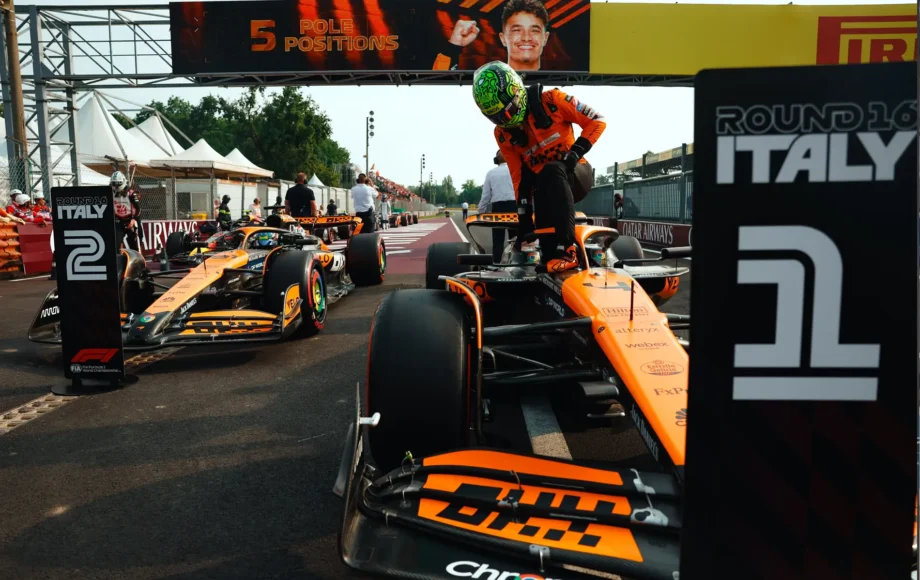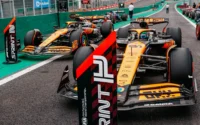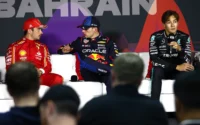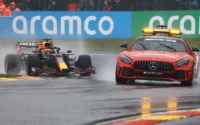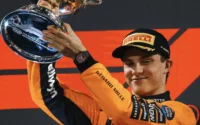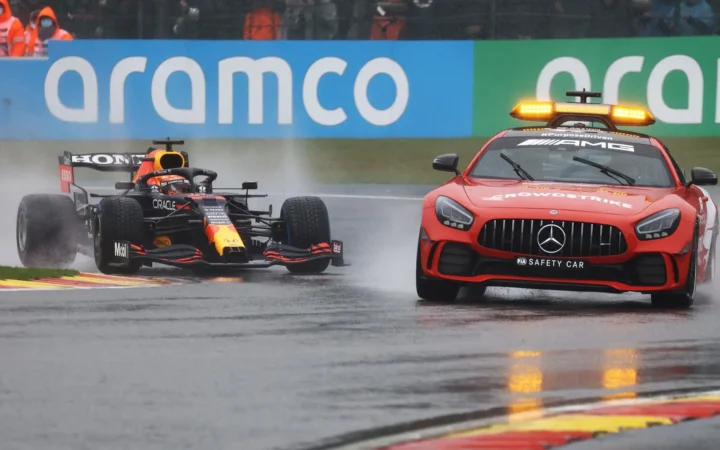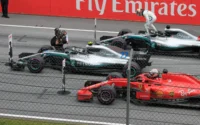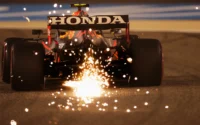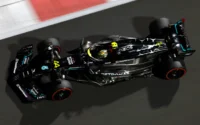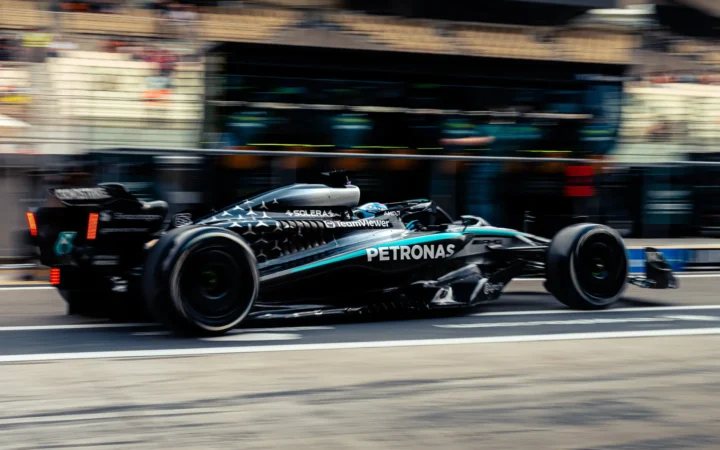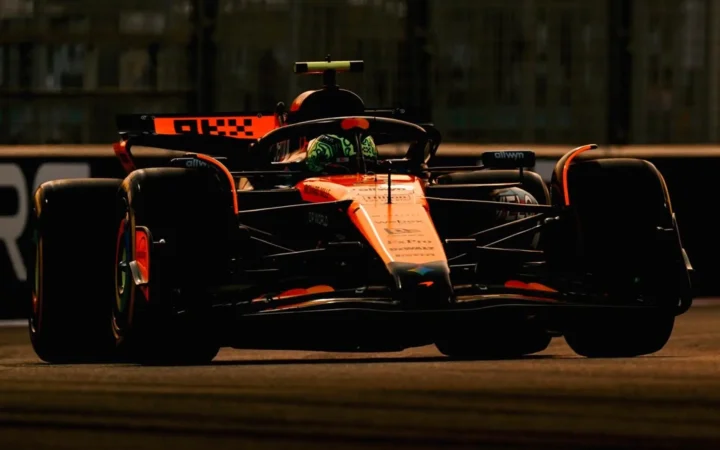In F1, there is a little-known but compulsory rule that can disqualify a car and driver before the race even begins. It’s called the 107% Rule, and while it rarely makes headlines, this regulation serves as a gatekeeper to the Grand Prix itself.
What To Know?
- How the Rule Works: In dry Q1 conditions, any driver not within 107% of the fastest time may be excluded from the race unless granted special permission.
- Exceptions Do Exist: If a driver fails in Q1 but shows acceptable pace in practice sessions, stewards can allow them to race from the back of the grid.
- Why It Still Matters: Reintroduced in 2011, the rule remains a tool to prevent dangerously slow or uncompetitive cars from participating in the race.
Introduced initially to maintain the competitive standard of the grid, the 107% Rule ensures that all cars participating in an F1 race are within a minimum performance range of the front-runners. While the modern era of multimillion-dollar teams, closer performance between them, and highly reliable cars may have rendered this rule less influential, it remains in place as a reminder that in F1, being on the grid is a privilege, not a guarantee.
Let’s dive into what the 107% Rule is, why it was introduced, and how it has evolved for the modern Formula 1 era.
What Is the 107% Rule?
The 107% Rule is a qualifying regulation that applies during Q1, the first session of Formula 1’s three-part knockout qualifying format. It states:
“Any driver who fails to set a lap within 107% of the fastest Q1 time will not be allowed to start the race—unless the race stewards grant an exception.”
Formula One History Recommends
Example:
If the fastest Q1 time is 1 minute 40 seconds (100s), then any driver who sets a lap slower than 1 minute 47 seconds (107s) is outside the limit.
This rule is enforced only under dry conditions. If the track is declared wet during Q1, the 107% Rule is waived entirely.
Why the 107% Rule Was Introduced
In the mid-1990s, Formula 1 had a quality problem. While grid sizes were shrinking, performance gaps were growing significantly. Teams like Forti and Pacific were bringing underdeveloped cars and pay drivers to gain sponsor exposure, often qualifying many seconds off the pace.
In 1995, the FIA noticed that the lack of a qualification threshold meant any car on the entry list would race, regardless of how far off the pace it was. This eroded the competitive integrity of the grid.
FIA President Max Mosley defended the move by stating: “Any small team which is properly organised will be able to get within the 107 percent margin.”
And Bernie Ecclestone was even more direct: “Formula 1 is the best. And we don’t need anything in it that isn’t the best.”
The rule came into effect for the 1996 season, beginning with the 1996 Australian Grand Prix.
When the Rule First Mattered
The 107% Rule had an immediate effect. At its debut race in 1996, both Forti drivers failed to qualify, proving that the rule was effective.
Throughout the late 1990s, several teams and drivers struggled to meet the 107% benchmark:
- Forti, again, missed multiple races in 1996 before folding mid-season.
- Giovanni Lavaggi, a pay driver at Minardi, failed to qualify on three separate occasions in 1996.
- In 1997, Pedro Diniz was given special dispensation to race after lapping within the limit during free practice.
By the time the rule was suspended in 2003, it had been applied across 23 of 116 Grand Prix, affecting 37 drivers. In 13 of those cases, the drivers were still allowed to race due to exceptional circumstances—usually wet sessions, crashes, or strong pace in practice.
Why the Rule Disappeared (and Came Back)
The 107% Rule was dropped in 2003 due to changes in qualifying. Formula 1 switched to a single-lap qualifying format where cars ran on race fuel, making lap times inherently unbalanced. Implementing a percentage-based rule like 107% became impractical and unfair under such conditions.
Formula One History Recommends
But by 2010, the regulations had changed again. With the reintroduction of low-fuel, three-part qualifying—and the arrival of new, underfunded teams like HRT, Virgin, and Caterham—concerns about pace disparity resurfaced. FIA President Jean Todt pushed for the rule’s return, and in 2011, it was formally reintroduced—this time applying only to Q1, and only in dry conditions.
When has the 107% Rule Been Used Recently?
Since its return, the 107% Rule has only occasionally been used—but when it has, it’s been high profile:
- 2011 Australian Grand Prix: Both HRT drivers (Vitantonio Liuzzi and Narain Karthikeyan) were excluded after failing to meet the 107% time.
- 2012 Australian Grand Prix: The same story, different year—Pedro de la Rosa and Karthikeyan, again for HRT, failed to qualify.
In most other modern cases, when drivers failed to meet the threshold, they were allowed to race due to:
- Wet or disrupted qualifying (e.g., 2016 Hungarian Grand Prix)
- Competitive lap times in practice (e.g., 2018 British Grand Prix: Lance Stroll and Brendon Hartley)
In 2018, the FIA updated the rules to exclude the 107% Rule from wet qualifying sessions, accepting the variability and lack of fairness in such conditions.
Key Exemptions and Stewards’ Discretion
The rule isn’t absolute. The FIA Sporting Regulations (Article 35.1, 2018) state:
“Under exceptional circumstances, which may include setting a suitable lap time in a free practice session, the stewards may permit the car to start the race.”
These drivers are then placed at the back of the grid, behind anyone serving penalties. If multiple drivers qualify via this exception, their grid positions are based on their Q3 classification.
This system strikes a balance between enforcing the rule and offering a level of flexibility, allowing competent drivers to race even if qualifying didn’t go their way.
The 107% Rule may not steal headlines or win titles, but it’s a rule that has evolved with the sport, made exceptions for changing eras, and yet still stands as a gatekeeper of performance. For teams dreaming of entering the sport, the message is clear: show up ready, or don’t show up at all.
List of 107% Rule Violations
107% Rule in its First Iteration: 1996–2002
| Year | Event | Pole position time | 107% time | Driver | Team | Time | % of pole | Raced? |
|---|---|---|---|---|---|---|---|---|
| 1996 | 1996 Australian Grand Prix | 1:32.371 | 1:38.837 | Luca Badoer | Forti | 1:39.202 | 107.395 | No |
| Andrea Montermini | 1:42.087 | 110.518 | No |
|||||
| 1996 European Grand Prix | 1:18.941 | 1:24.467 | Andrea Montermini | Forti | 1:25.053 | 107.742 | No |
|
| Luca Badoer | 1:25.840 | 108.739 | No |
|||||
| 1996 San Marino Grand Prix | 1:26.890 | 1:32.972 | Andrea Montermini | Forti | 1:33.685 | 107.802 | No |
|
| 1996 Spanish Grand Prix | 1:20.650 | 1:26.295 | Luca Badoer | Forti | 1:26.615 | 107.396 | No |
|
| Andrea Montermini | 1:27.358 | 108.317 | No |
|||||
| 1996 British Grand Prix | 1:26.875 | 1:32.956 | Andrea Montermini | Forti | 1:35.206 | 109.590 | No |
|
| Luca Badoer | 1:35.304 | 109.702 | No |
|||||
| 1996 German Grand Prix | 1:43.912 | 1:51.186 | Giovanni Lavaggi | Minardi | 1:51.357 | 107.165 | No |
|
| 1996 Belgian Grand Prix | 1:50.574 | 1:58.314 | Giovanni Lavaggi | Minardi | 1:58.579 | 107.239 | No |
|
| 1996 Japanese Grand Prix | 1:38.909 | 1:45.833 | Giovanni Lavaggi | Minardi | 1:46.795 | 107.973 | No |
|
| 1997 | 1997 Australian Grand Prix | 1:29.369 | 1:35.625 | Pedro Diniz | Arrows | 1:35.972 | 107.388 | Yes |
| Vincenzo Sospiri | Lola | 1:40.972 | 112.988 | No |
||||
| Ricardo Rosset | 1:42.086 | 114.230 | No |
|||||
| 1998 | 1998 Spanish Grand Prix | 1:20.262 | 1:25.880 | Ricardo Rosset | Tyrrell | 1:25.946 | 107.082 | No |
| 1998 Monaco Grand Prix | 1:19.798 | 1:25.383 | Ricardo Rosset | Tyrrell | 1:25.737 | 107.443 | No |
|
| 1998 Hungarian Grand Prix | 1:16.973 | 1:22.361 | Ricardo Rosset | Tyrrell | 1:23.140 | 108.012 | No |
|
| 1998 Japanese Grand Prix | 1:36.293 | 1:43.033 | Ricardo Rosset | Tyrrell | 1:43.259 | 107.234 | No |
|
| 1999 | 1999 Australian Grand Prix | 1:30.462 | 1:36.794 | Marc Gené | Minardi | 1:37.013 | 107.242 | Yes |
| 1999 French Grand Prix | 1:38.441 | 1:45.331 | Damon Hill | Jordan Grand Prix | 1:45.334 | 107.002 | Yes |
|
| Marc Gené | Minardi | 1:46.324 | 108.008 | Yes |
||||
| Luca Badoer | 1:46.784 | 108.475 | Yes |
|||||
| Pedro de la Rosa | Arrows | 1:48.215 | 109.929 | Yes |
||||
| Toranosuke Takagi | 1:48.322 | 110.038 | Yes |
|||||
| 2001 | 2001 Australian Grand Prix | 1:26.892 | 1:32.974 | Tarso Marques | Minardi | 1:33.228 | 107.292 | Yes |
| 2001 British Grand Prix | 1:20.447 | 1:26.078 | Tarso Marques | Minardi | 1:26.508 | 107.534 | No |
|
| 2001 Belgian Grand Prix | 1:52.072 | 1:59.917 | Jos Verstappen | Arrows | 2:02.039 | 108.893 | Yes |
|
| Fernando Alonso | Minardi | 2:02.594 | 109.389 | Yes |
||||
| Enrique Bernoldi | Arrows | 2:03.048 | 109.794 | Yes |
||||
| Tarso Marques | Minardi | 2:04.204 | 110.825 | Yes |
||||
| 2002 | 2002 Australian Grand Prix | 1:25.843 | 1:31.852 | Takuma Sato | Jordan Grand Prix | 1:53.351 | 132.045 | Yes |
| 2002 San Marino Grand Prix | 1:21.091 | 1:26.767 | Alex Yoong | Minardi | 1:27.241 | 107.584 | No |
|
| 2002 British Grand Prix | 1:18.998 | 1:24.527 | Alex Yoong | Minardi | 1:24.785 | 107.291 | No |
|
| 2002 French Grand Prix | 1:11.985 | 1:17.023 | Heinz-Harald Frentzen | Arrows | 1:18.497 | 109.046 | No |
|
| Enrique Bernoldi | 1:19.843 | 110.916 | No |
|||||
| 2002 German Grand Prix | 1:14.389 | 1:19.596 | Alex Yoong | Minardi | 1:19.775 | 107.240 | No |
107% Rule After Adoption by First Qualifying Round: 2011–
| Year | Event | Q1 fastest time | 107% time | Driver | Team | Time | % of fastest | Raced |
|---|---|---|---|---|---|---|---|---|
| 2011 | 2011 Australian Grand Prix | 1:25.296 | 1:31.266 | Vitantonio Liuzzi | HRT Formula 1 Team | 1:32.978 | 109.006 | No |
| Narain Karthikeyan | 1:34.293 | 110.547 | No |
|||||
| 2011 Canadian Grand Prix | 1:13.822 | 1:18.989 | Jerome d’Ambrosio | Virgin Racing | 1:19.414 | 107.575 | Yes | |
| 2011 Belgian Grand Prix | 2:01.813 | 2:10.339 | Jerome d’Ambrosio | Virgin Racing | 2:11.601 | 108.035 | Yes | |
| Vitantonio Liuzzi | HRT Formula 1 Team | 2:11.616 | 108.047 | Yes | ||||
| Daniel Ricciardo | 2:13.077 | 109.246 | Yes | |||||
| 2011 Indian Grand Prix | 1:26.189 | 1:32.222 | Timo Glock | Virgin Racing | 1:34.046 | 109.116 | Yes | |
| 2012 | 2012 Australian Grand Prix | 1:26.182 | 1:32.214 | Pedro de la Rosa | HRT Formula 1 Team | 1:33.495 | 108.486 | No |
| Narain Karthikeyan | 1:33.643 | 108.658 | No | |||||
| 2012 Spanish Grand Prix | 1:22.583 | 1:28.363 | Narain Karthikeyan | HRT Formula 1 Team | 1:31.122 | 110.340 | Yes | |
| 2012 British Grand Prix | 1:46.279 | 1:53.718 | Charles Pic | Marussia F1 | 1:54.143 | 107.399 | Yes | |
| 2013 | 2013 Australian Grand Prix | 1:43.380 | 1:50.616 | Charles Pic | Caterham F1 | 1:50.626 | 107.009 | Yes |
| 2014 | 2014 British Grand Prix | 1:40.380 | 1:47.406 | Marcus Ericsson | Caterham F1 | 1:49.421 | 109.006 | Yes |
| Kamui Kobayashi | 1:49.625 | 109.210 | Yes | |||||
| 2015 | 2015 Malaysian Grand Prix | 1:39.269 | 1:46.217 | Roberto Merhi Merhi | Marussia F1 | 1:46.677 | 107.462 | Yes |
| 2015 Japanese Grand Prix | 1:33.015 | 1:39.386 | Alexander Rossi | Marussia F1 | 1:47.114 | 115.158 | Yes | |
| 2015 United States Grand Prix | 1:56:495 | 2:04.650 | Carlos Sainz | Toro Rosso | 2:07.304 | 109.279 | Yes | |
| 2016 | 2016 Monaco Grand Prix | 1:14.912 | 1:19.832 | Max Verstappen | Red Bull Racing | 1:22.467 | 110.085 | Yes |
| 2016 Hungarian Grand Prix | 1:33.302 | 1:39.833 | Daniel Ricciardo | Red Bull Racing | 1:39.968 | 107.145 | Yes | |
| Max Verstappen | 1:40.424 | 107.663 | Yes | |||||
| Sergio Perez | Force India | 1:41.411 | 108.691 | Yes | ||||
| Nico Hulkenberg | 1:41.471 | 108.755 | Yes | |||||
| Valtteri Bottas | Williams | 1:42.758 | 110.135 | Yes | ||||
| Jolyon Palmer | Renault | 1:43.965 | 111.428 | Yes | ||||
| Felipe Massa | Williams | 1:43.999 | 111.465 | Yes | ||||
| Kevin Magnussen | Renault | 1:44.543 | 112.048 | Yes | ||||
| Marcus Ericsson | Sauber | 1:46.984 | 114.664 | Yes | ||||
| Pascal Wehrlein | Manor Racing | 1:47.343 | 115.049 | Yes | ||||
| Rio Haryanto | 1:50.189 | 118.099 | Yes | |||||
| 2017 | 2017 Italian Grand Prix | 1:35.716 | 1:42.416 | Romain Grosjean | Haas | 1:43.355 | 107.226 | Yes |
| 2018 | 2018 Azerbaijan Grand Prix | 1:42.538 | 1:49.715 | Brendon Hartley | Toro Rosso | 1:57.354 | 114.449 | Yes |
| 2021 | 2021 French Grand Prix | 1:31.001 | 1:37.371 | Lance Stroll | Aston Martin | 2:12.584 | 145.695 | Yes |
| 2023 | 2023 Saudi Arabian Grand Prix | 1:28.761 | 1:34.974 | Logan Sargeant | Williams | 2:08.510 | 144.782 | Yes |
| 2023 Azerbaijan Grand Prix | 1:41.269 | 1:48.357 | Nyck de Vries | AlphaTauri | 1:55.282 | 113.837 | Yes | |
| 2023 Qatar Grand Prix Sprint | 1:24.454 | 1:30.366 | Logan Sargeant | Williams | 2:05.741 | 137.586 | Yes |
For more F1 Terms, check out our F1 Glossary, covering everything from DRS and G-force to oversteer, slipstreaming, tyre warmers, or even the 75% rule or 90% rule. This guide offers clear explanations of the most frequently used F1 terms. You’ll be speaking the language of Formula 1 like a seasoned fan in no time.
Seen in:

